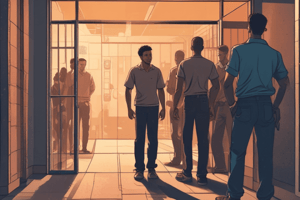Podcast
Questions and Answers
True or false:In the past, black youthful offenders were often prosecuted in juvenile courts and placed in juvenile facilities.
True or false:In the past, black youthful offenders were often prosecuted in juvenile courts and placed in juvenile facilities.
False (B)
True or false: The institutionalization of youthful offenders was not a primary determination and outcome for those involved with the juvenile courts.
True or false: The institutionalization of youthful offenders was not a primary determination and outcome for those involved with the juvenile courts.
False (B)
True or false: Community-based corrections, such as halfway houses, were not introduced as a way to deal with youthful offenders.
True or false: Community-based corrections, such as halfway houses, were not introduced as a way to deal with youthful offenders.
False (B)
True or false: Juvenile court dockets did not expand to include more minor offenses and child welfare concerns.
True or false: Juvenile court dockets did not expand to include more minor offenses and child welfare concerns.
True or false: The federal government did not play a role in state reform and depopulating overcrowded juvenile incarceration facilities.
True or false: The federal government did not play a role in state reform and depopulating overcrowded juvenile incarceration facilities.
True or false: Youthful offenders were often housed with adults in local jails in the past.
True or false: Youthful offenders were often housed with adults in local jails in the past.
True or false: States did not shift their correctional facilities towards smaller, community, home-type environments.
True or false: States did not shift their correctional facilities towards smaller, community, home-type environments.
True or false: Due process protection rights and legal protections for youthful offenders were not a focus of reform efforts.
True or false: Due process protection rights and legal protections for youthful offenders were not a focus of reform efforts.
True or false: The law-and-order approach to dealing with youthful offenders did not result in increased juvenile detention and incarceration.
True or false: The law-and-order approach to dealing with youthful offenders did not result in increased juvenile detention and incarceration.
True or false: Preventative or intervention programs were found to be effective with delinquent adolescents.
True or false: Preventative or intervention programs were found to be effective with delinquent adolescents.
True or false: Today's juvenile court reform focuses on improving public safety, investing in effective prevention and treatment alternatives, and diverting all youthful offenders away from the courts.
True or false: Today's juvenile court reform focuses on improving public safety, investing in effective prevention and treatment alternatives, and diverting all youthful offenders away from the courts.
True or false: Independent foundations, such as the MacArthur Foundation and the Annie E. Casey Foundation, have played a role in many of the juvenile justice reforms implemented by states.
True or false: Independent foundations, such as the MacArthur Foundation and the Annie E. Casey Foundation, have played a role in many of the juvenile justice reforms implemented by states.
Flashcards are hidden until you start studying
Study Notes
- Black youthful offenders were prosecuted in adult courts and placed in adult prisons, as well as involved in the convict leasing system.
- Institutionalization of youthful offenders became the primary determination and outcome for those involved with the juvenile courts.
- Community-based corrections were introduced, such as group homes, partial release supervision, and halfway houses.
- Juvenile court dockets expanded to include more minor offenses, truancy issues, and child welfare concerns.
- Stronger federal government role, state reform, and depopulating overcrowded juvenile incarceration facilities were established.
- Youthful offenders to be separated from adults in local jails, status offenders to be removed from juvenile institutions, and removal of adolescents from the adult criminal justice system unless charged and transferred as adults.
- States shifted their large-scale and often poorly maintained correctional facilities towards smaller, community, home-type environments.
- Increased focus on due process protection rights and legal protections for youthful offenders.
- Law-and-order approach to dealing with youthful offenders and increased juvenile detention and incarceration.
- Opinions vary on the most effective approach to juvenile justice.
- Juvenile crime was believed to be out of control by both liberal and conservative stakeholders and policy makers.
- Juvenile courts were seen as soft on crime and ineffective.
- Preventative or intervention programs did not work with delinquent adolescents.
- Growing crime problem in the youthful offender population but was short-lived.
- Increase in handgun access and usage alongside expanding drug trade in impoverished communities.
- Public reaction, media coverage, and policy makers' responses were disproportionate to what was actually happening.
- Today's juvenile court reform focuses on improving public safety, diverting first-time and low-level youthful offenders away from the courts, and investing in effective prevention and treatment alternatives.
- Many states have implemented evidence-based practices and rigorous evaluation methods.
- Independent foundations, such as the MacArthur Foundation and the Annie E. Casey Foundation, have led many of these reforms.
- Federal trends have shifted states toward a rehabilitative paradigm and require them to determine the existence and extent of their disproportionate contact and confinement of minority youthful offenders.
Studying That Suits You
Use AI to generate personalized quizzes and flashcards to suit your learning preferences.



